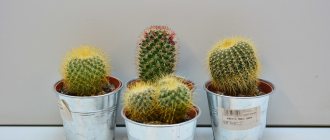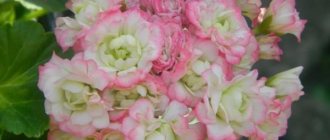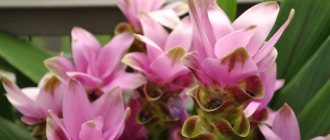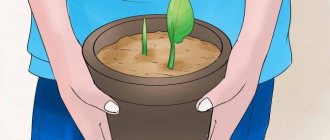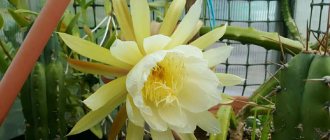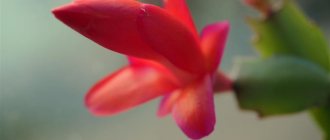Cacti can be called the most durable plants on the planet. They adapt to extreme heat and drought and grow in places where other green spaces simply cannot survive. Cacti belong to the perennials of the order Dianthus; there are hundreds of species in the world, some of which are found in the Atacama Desert, where the highest temperatures on Earth are recorded.
At their core, these flowers are succulents, which, when kept at home, do not require careful care and are not capricious.
We associate cacti with thorns; some varieties look downright scary, such as Tunilla. Its flat sheets with small spines are very similar to a kitchen grater: as soon as you lose your vigilance, they will scratch you and draw blood. But there are such plants without thorns at all. They are beautiful and completely safe. Let's take a closer look at them.
Hathiora
When you first look at this plant, you would absolutely not think that it is a cactus. Hatiora has neither thorns nor leaves. Instead, there are many stems, branching in different directions and resembling individual segments. For such an original appearance, the British call this flower the dancing bones cactus. Brazil is considered its homeland, from where the flower has spread to many countries. In temperate climates, Hatiora thrives well, as it does not like too high temperatures. The optimal temperature in summer is up to 22 degrees above zero.
Yellow “bells” appear at the ends of the stems in February-March. With the arrival of summer, the flower can be taken out into the fresh air and watered once every five days, while protecting it from drafts.
In winter, the crop does not need frequent watering - once every two weeks is enough. It is important to let the soil dry out well.
General characteristics of succulents
The living conditions of succulents in nature can be called extreme. Some species of cacti grow in very high temperatures, while others are subject to daily temperature fluctuations that would kill other plants. There are also those that grow in very wet soils.
The soil in which cactus plants live is poor in nutrients. Most often these are sand or rocky soils with a minimal amount of organic matter. Some varieties of cacti cannot tolerate nitrogen compounds in the soil, so when purchasing an exotic plant, you need to know its needs and limitations.
Although succulents are a relatively new family of plants, they are very diverse in appearance. Their homeland is South America, from where, with the help of birds, the cultures spread throughout the world.
Types of home hybrid cacti are also numerous. These are small plants adapted to apartment conditions. They are planted individually and in compositions to create the appearance of tropical variety.
Each type of cacti is capable of blooming with very bright, numerous flowers, but for this the plant must be comfortable. To achieve flowering, you need to have a good knowledge of the agricultural technology of a given plant and varietal characteristics.
Rhipsalis
Most often, rhipsalis is found in South America, but it also grows in some regions of India. The flower does not look like a cactus at all, since the stems are devoid of thorns, have a rounded, sometimes ribbed shape, and are capable of hanging and branching, which is why rhipsalis decorates the interiors of houses, suspended in baskets. By the way, when kept at home, this plant often pleases with flowers of various shades: white, red, pink, yellow.
The temperature for keeping rhipsalis should not be below ten degrees, and the lighting is not too bright for it. The roots of the flower are aerial, requiring constant spraying. From the beginning of spring until the arrival of autumn, rhipsalis must be watered so that moisture is always retained in the ground. Fertilizing the flower will not hurt either.
Classification of cacti according to group characteristics
All representatives can be divided into three groups:
These types differ in structure. Thus, Pereskieves have round stems and flat leaves , which are covered with straight spines. They often bloom with single flowers. It is distinguished by edible fruits.
Opuntia cacti are distinguished by small leaves covered with spines . In addition to spines, they also have glochidia. Glochidia are modified leaves of a plant. Large flowering. The colors are varied. The fruits are in most cases edible.
Cereus species lack leaves and glochidia . This is the largest family, which includes various species. Some representatives have edible fruits. Basically, Cereus cacti prefer arid areas.
Epiphyllum
This plant, which received the popular name “forest cactus,” “came out” from the tropics of America. Epiphyllum has neither leaves nor spines - they are replaced by flat or triangular stems, painted in a rich green hue. Flower growers love this cactus because of its very beautiful flowering. The diameter of the flowers, which can be orange, purple, white, reaches 12 centimeters!
If you want to plant an epiphyllum and enjoy its beauty, protect it from direct exposure to ultraviolet radiation. The best place for a flower is where there is diffused light. Fully shaded areas are not suitable for keeping this type of cacti. Make sure that the temperature in the room where the epiphyllum is located is in the range of +20 - +25 degrees , and in winter - +12 - +15 degrees. The flower does not have any special requirements for air humidity.
Varieties of home cacti
There are dozens of types of cacti that can be grown at home. Flower growers love them due to their good decorative qualities and ease of cultivation.
Peyote cactus
Soil for cacti: basic soil requirements and options at home
The northern part of Mexico and Arizona are considered to be the birthplace of the peyote cactus Lophophora Williams. The decorative qualities of the plant are inconspicuous: it is a small green mass of a flattened spherical shape. During flowering, white and pink flowers are formed.
Note! The plant is capable of self-pollination, so throughout the entire growing season it is possible to see edible pink berries with seeds on the plant.
Previously, it was in great demand among Indian shamans for healing and prophecy. This is due to the fact that the composition contains a considerable concentration of the narcotic substance – mescaline. Mescaline cacti contain more than 50 alkaloids. Growing peyote crops at home where there are children and pets is strongly discouraged.
Lophophora Williams
Cactus mix
Homemade cacti mix combines several varieties. Each of them is the result of crossing different types of succulents. The most popular varieties are:
- Stenocactus is characterized by a large number of ribs that bend in small zigzags. There are not very many spines on its surface.
- Echinocactus Gruzoni is a spherical culture, the diameter of which at home can reach half a meter. The surface is abundantly covered with large rosettes of yellow-colored spines.
- Epostoa has won the love of flower growers with its unusual “fluffiness”. It seems to be an ordinary cactus, but without thorns. Instead, soft and long hairs grow.
Cacti mix
Cactus Indian line
A flowering cactus, which also belongs to the mixes. The plant may look different. Characteristics:
- Miniature sizes.
- The presence of white spines on the stem. There may or may not be many of them, but they are always white.
Note! Indian Line cacti are never flat. They are characterized by a spherical shape.
Indian line
And others
It is worth considering a few more varieties that are less popular, but also deserve the attention of gardeners:
- Mamillaria are miniature ball-shaped plants. Their characteristic feature is that the cactus flowers open with long thorns. Some varieties are completely entangled in them. The decorative qualities are very interesting and unusual. During flowering, several flowers are formed at the top of the stem.
- Prickly pear is a decorative plant with a flat body and a large number of small spines. The leaves, flower and fruits of this plant are edible.
You can purchase high-quality seed material or a small plant in specialized flower and garden stores.
Pereskia
When in bloom, this cactus looks more like a rose. It is one of the most ancient plants on the planet, growing in the driest and hottest places. Pereschia looks like a small tree, its smooth and succulent leaves can be colored green or purple. They have small spines, but they are practically invisible. Pereskia loves a lot of sun and warmth, the optimal temperature for keeping it is from +22 to +25 degrees . It is recommended to water the plant as the soil in the pot dries out. The less often you do this, the better this flower will feel.
Parody
This cactus is from a fairly large family of Cactaceae. Its homeland is South America. Under natural conditions, areas with rocky rocks are chosen for growth. The stem has the shape of a ball with pronounced ribs. Depending on the species, it has from one flower at the top to a dozen.
Regardless of the time of year, the plant requires rich lighting, but direct sunlight is well tolerated by those species that have many thorns. The best species for indoor breeding of Parodies: Golden-spined, Golden-needle, Snowy, Schwebsa, Small-seeded, Racemose, Ritters, Majestic and several others.
The temperature in spring and summer should be 20-24 degrees, in the fall the temperature is reduced to 15, and in winter to 10 degrees. The plant should remain dormant all winter, but always in a lighted part of the room.
In the summer, watering should be carried out regularly, but after the substrate has completely dried. To prepare the cactus for winter dormancy, reduce watering. Water for irrigation is taken soft or purified through a filter.
Lophophora
The second name of this cactus, which is native to America and Mexico, is peyote. Its shape is spherical, consisting of convex parts, the surface of the stem is velvety. Lophophora blooms exclusively in summer. The tubular flowers with many red or white petals are small in size and reach only two centimeters in diameter.
Such a flower can decorate any interior, but only with proper care. Lophophora prefers diffused light and can withstand high temperatures, so in summer it can be left outside even in extreme heat. However, with the arrival of winter, care should be taken to ensure that the air temperature in the room where it is kept does not rise above ten degrees. Therefore, place this green darling on the veranda or balcony. Watering should be done a few days after the soil in the pot has completely dried out. Experts advise feeding the flower with fertilizers during periods of intensive growth at least once a month.
Notocactus
Botanists brought this plant into the Cactus family. It grows mostly in Paraguay and Brazil. There are approximately 20 species, but only a few are suitable for indoor floriculture. The most common three types: Graceful, Reddish, Yellow-pink. They all bloom beautifully.
The stem of Notocactus is spherical or cylindrical, with strongly pronounced ribs, covered with numerous bunches of spines. The plant needs to receive enough light. Daylight hours should not be less than 10 hours. This can be milked in winter only with the plant illuminated.
Also read: Echinocactus gruzoni - a spiny ball from Mexico
In summer, a temperature of 22-25 degrees is very suitable for notocactus, but in order for the plant to bloom, it must be in a dormant period in winter at a temperature of about 10 degrees Celsius.
Watering in spring and summer is plentiful; the substrate should not be allowed to dry out; in winter, watering is reduced. The water should be soft or rain. You can use filtered water.
Features of caring for cacti
The fact that cacti are one of the most unpretentious plants does not mean that they are not worth caring for. Each species needs special treatment, but there are general rules that must be followed in order for the cactus to become a decoration for your room.
Cacti, which naturally grow in deserts, love plenty of sunlight. For this reason, it is better to place them on the window sills of windows facing South. If you don’t have such a window in your house, the east side will do. Forest cacti are designed to be placed on the south or north sides. From excess sun, their leaves and stems will become pale, and the plants may not survive the dormant periods between flowerings.
In late spring and summer, take cacti outside, but only if the weather is sunny and warm. Abundant rainfall will not benefit such green pets. If the heating in your apartment is too hot in winter, keep these plants cool. They can be placed on a glazed balcony or in another place. You can also solve the problem by increasing the humidity in the room. In winter, it is better to move cacti from the south side to the north. The main thing is that the air temperature does not rise above +17 degrees.
Despite the fact that cacti have a reputation for being drought-resistant species, watering cannot be completely avoided. All plants need water, so water your succulents as the soil in their pots dries out. Use settled water at room temperature, and, if possible, accumulate rain or melt water, which is ideal for caring for most green spaces. In spring and summer, watering is carried out once every two to five days, in autumn - once a week, in winter - once every one and a half to two weeks.
Popular cactus colors
Plants can have different colors. The most common ones include grayish and green.
Pink cacti
In order for an ornamental crop to take on this color, it needs to be slightly modified, artificially preventing the development of chloroplasts. It is these segments that are responsible for all shades of green in nature.
Note ! Without chloroplast, normal photosynthesis is impossible, which has an extremely negative effect on the health and vital activity of any representative of the flora.
Pink succulents
Reds
The crop can also have a red color, but only on top. An example of such a plant is Gymnocalycium Mihanovich. It was this that marked the beginning of the creation of colored cacti.
The red upper part represents the scion, which cannot exist without the rootstock - the lower part.
Red succulents (Gymnocalycium Michanovich)
Blue
Blue representatives of cacti are extremely rare, but in nature there are species of blue color. This is their natural color, everything happened without human intervention. The name of the plant is Cereus Myrtillocactus geometrizans.
Cereus Myrtillocactus geometrizans
How to propagate a cactus
Cacti can be propagated either by seeds or by shoots. The second method, which has proven its effectiveness, is very popular among gardeners. The shoots, as is the case with most plants, are taken from adult specimens and then rooted. The process proceeds quite quickly.
In stores you can buy planting material - seeds. Before placing them in the ground, they should be disinfected in a manganese solution. Germination occurs in a humid environment. Some species produce shoots after a day, but there are also those that take months to do this.
Examples of cacti with leaves
Picture 14. Succulent with leaves (Pasipodium)
The vast majority of cacti do not have the usual leaves, but there are a few exceptions. The most striking representative with long leaves is the Pasipodium cactus. The trunk of the bush stores moisture, the leaves grow only in the upper part. Visually it has a lot in common with the Madagascar palm.
The length of each leaf can reach 75% of the length of the stem, which can grow up to 8 meters.
Important! The plant is poisonous. Therefore, growing it at home is strongly not recommended, especially if there are small children and/or pets in the apartment.
Reproduction
If you suddenly want to propagate Opuntia, you can do this in two ways:
- Seeds;
- By cuttings.
Seeds
This method is not very popular, because it is quite problematic. Not all seeds germinate, and it even happens that none at all. We have previously written about how to grow cacti from seeds, so the principle here is exactly the same, but there is one difference. Opuntia seeds have a rather dense shell, so they should first be rubbed with a file or sandpaper, and then soaked in potassium permanganate.
And then everything is as usual. Soil is poured into the greenhouse, holes are made there and seeds are planted. After this, you need to wait for shoots. The first transplant is performed after 3 months. More details are written in our separate article.
Cuttings
The most preferred method, which is much more effective than the previous one. There is nothing complicated about cuttings. First of all, take a well-sharpened knife and select any healthy shoot on the stem. Then, it should be cut off and then placed in an upright position in a place where it can dry a little. Usually it takes 3-4 days until a film appears at the cut site.
Also read: Cacti with names starting with the letter “A” - list of species
Next, the dried cuttings should be planted in a container with wet sand, to a depth of 5-6 cm. The container itself must be covered with cling film and allowed to be ventilated periodically, as well as occasionally watered. As soon as the seedling has roots, it should be transplanted. How to do this can be read above.
Beautiful cactus Discocactus (Discocactus horstii)
Discocactus horstii species
In adulthood, it forms the so-called
cephalium
- a perennial inflorescence from which
large white flowers
. In the early stages of development, the cactus is green in color, but later acquires a red tint.
Although it looks like a common desert cactus when young, this cactus species grows at altitudes of at least 300 meters
above sea level. It is quite difficult to grow at home, since it really does not like overwatering and can easily rot from high humidity. If you water it rarely, the cactus will dry out quickly, although most cacti cope with this task with ease.
